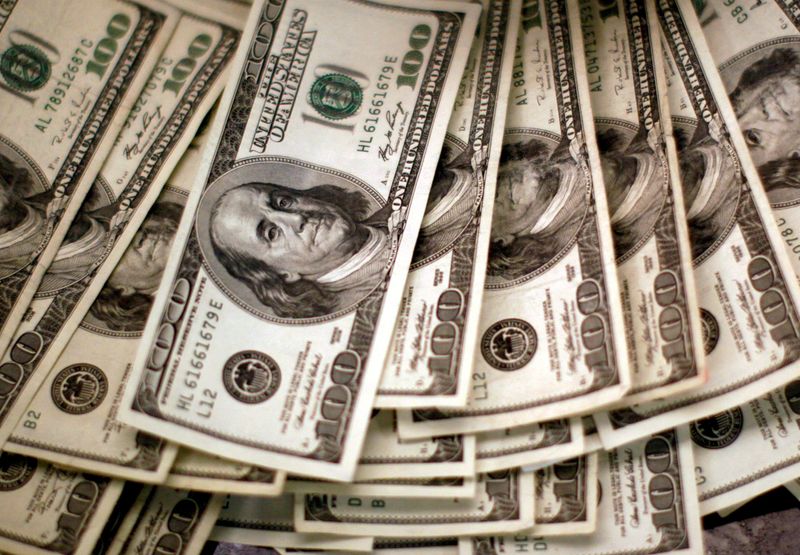Forex
US dollar gains as Fed comments on more rate hikes lend support


© Reuters. FILE PHOTO: U.S. dollars are counted out by a banker counting currency at a bank in Westminster, Colorado November 3, 2009. REUTERS/Rick Wilking/File Photo
By Gertrude Chavez-Dreyfuss
NEW YORK (Reuters) – The dollar rose against major currencies on Monday, broadly supported by Federal Reserve officials saying additional interest rate hikes are likely given that inflation remains persistently high and the labor market is still tight.
Fed Governor Michele Bowman said on Monday additional interest rate hikes will likely be needed to lower inflation to the U.S. central bank’s 2% target.
Bowman, in remarks prepared for delivery to a “Fed Listens” event in Atlanta, said she backed the latest rate increase last month because inflation remains too elevated, and job growth and other indications of activity show the economy has continued expanding at a “moderate pace.”
New York Fed President John C. Williams said, in an interview with the New York Times published on Monday, the central bank will need to keep the restrictive stance for some time. Maintaining that stance is going to be determined by the underlying fundamentals “driving, supply and demand in the economy, inflation,” he added.
In mid-afternoon trade, the dollar gained 0.5% against the yen to 142.45 yen, rising from a one-week low earlier in the session. The dollar was slightly up versus the Swiss franc at 0.8731 francs.
The was last little changed at 102.03. It fell to a one-week low last Friday in the wake of a U.S. non-farm payrolls report that came out weaker than expected.
Jeff Klingelhofer, portfolio manager and co-head of investments at Thornburg Investment Management, said he sees the dollar holding gains in the near to medium term.
“I’m expecting a longer pause from the Fed and that should be dollar-supportive just because of interest rate differentials. So the U.S. staying higher for longer should support the dollar,” said Klingelhofer.
“I also believe that if interest rates stay at higher levels, then inevitably you get that deeper recession when the consumer deteriorates. Then you get safe-haven flows that will be broadly supportive of the dollar.”
The Fed late last month raised its benchmark rate by a quarter percentage point to a range of 5.25% to 5.50%. Investors by and large believe that is likely the last increase of a campaign the Fed kicked off in March 2022.
In other currencies, the euro slipped against the greenback to $1.1006 after Monday’s data showed German industrial production in June dropped more strongly than forecast, falling 1.5% compared with the previous month.
Investors are also starting to focus on upcoming U.S. and Chinese inflation data. U.S. data out on Thursday is expected to show July core inflation at 4.7% on an annual basis. China will report July inflation on Wednesday, with traders on the lookout for further signs of deflation.
The dollar was last 0.2% higher against the offshore at 7.2024.
Sterling rose 0.3% against the dollar to $1.2783. Last Thursday, the Bank of England (BoE) raised interest rates by 25 basis points to a 15-year peak of 5.25%.
========================================================
Currency bid prices at 3:02PM (1902 GMT)
Description RIC Last U.S. Close Pct Change YTD Pct High Bid Low Bid
Previous Change
Session
Dollar index 102.0200 102.0600 -0.03% -1.420% +102.3800 +101.9600
Euro/Dollar $1.1007 $1.1012 -0.05% +2.73% +$1.1026 +$1.0966
Dollar/Yen 142.4150 141.7600 +0.47% +8.63% +142.5750 +141.5200
Euro/Yen 156.77 156.05 +0.46% +11.74% +156.8500 +155.8200
Dollar/Swiss 0.8729 0.8729 +0.01% -5.59% +0.8773 +0.8730
Sterling/Dollar $1.2783 $1.2752 +0.25% +5.70% +$1.2788 +$1.2714
Dollar/Canadian 1.3365 1.3383 -0.15% -1.37% +1.3399 +1.3340
Aussie/Dollar $0.6574 $0.6571 +0.05% -3.56% +$0.6593 +$0.6555
Euro/Swiss 0.9608 0.9608 +0.00% -2.90% +0.9627 +0.9604
Euro/Sterling 0.8609 0.8633 -0.25% -2.66% +0.8640 +0.8607
NZ $0.6108 $0.6098 +0.16% -3.80% +$0.6117 +$0.6087
Dollar/Dollar
Dollar/Norway 10.1390 10.1150 +0.37% +3.44% +10.2000 +10.1190
Euro/Norway 11.1643 11.1511 +0.12% +6.39% +11.1927 +11.1239
Dollar/Sweden 10.5774 10.5766 -0.05% +1.63% +10.6537 +10.5735
Euro/Sweden 11.6433 11.6490 -0.05% +4.43% +11.6904 +11.6332

 Forex3 years ago
Forex3 years agoForex Today: the dollar is gaining strength amid gloomy sentiment at the start of the Fed’s week

 Forex3 years ago
Forex3 years agoUnbiased review of Pocket Option broker

 Forex3 years ago
Forex3 years agoDollar to pound sterling exchange rate today: Pound plummeted to its lowest since 1985

 Forex3 years ago
Forex3 years agoHow is the Australian dollar doing today?

 Cryptocurrency3 years ago
Cryptocurrency3 years agoWhat happened in the crypto market – current events today

 World3 years ago
World3 years agoWhy are modern video games an art form?

 Commodities3 years ago
Commodities3 years agoCopper continues to fall in price on expectations of lower demand in China

 Economy3 years ago
Economy3 years agoCrude oil tankers double in price due to EU anti-Russian sanctions





















